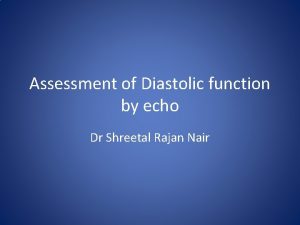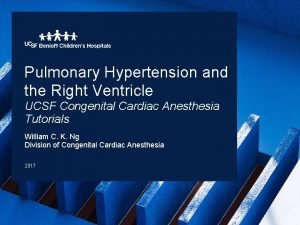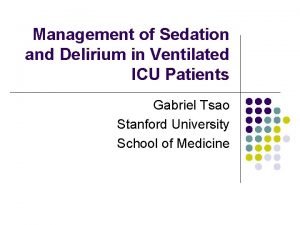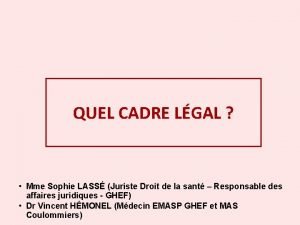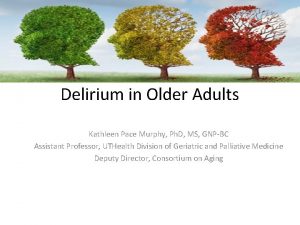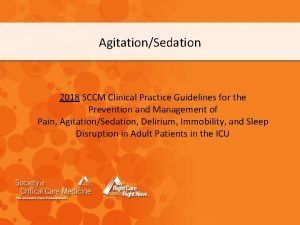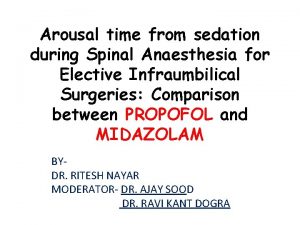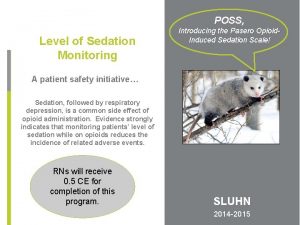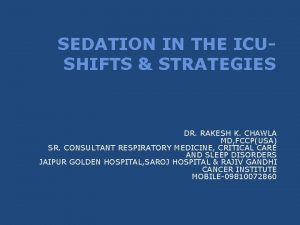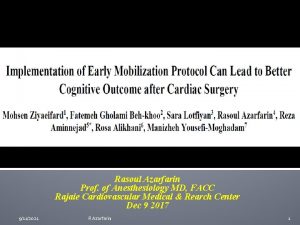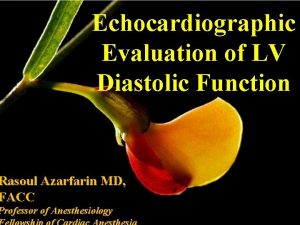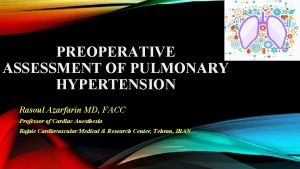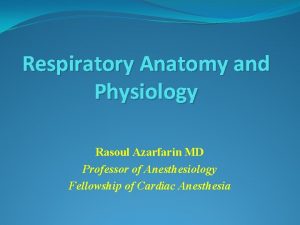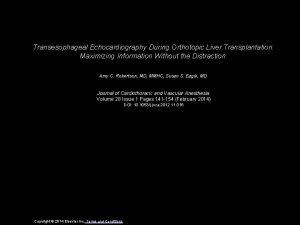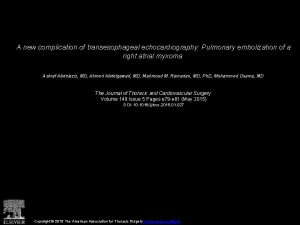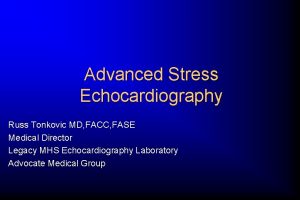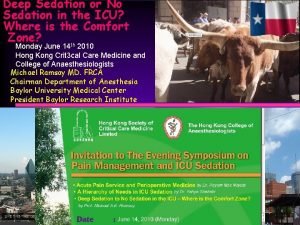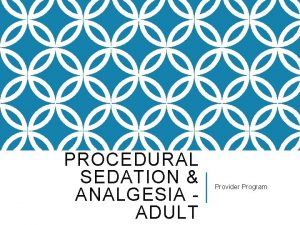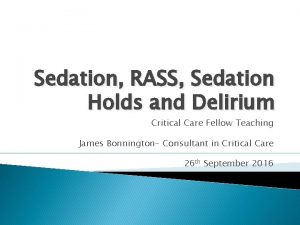Sedation for Transesophageal Echocardiography RASOUL AZARFARIN MD FACC




















- Slides: 20

Sedation for Transesophageal Echocardiography RASOUL AZARFARIN MD, FACC PROFESSOR OF ANESTHESIOLOGY FELLOWSHIP OF CARDIAC ANESTHESIA

Moderate Sedation/Analgesia: Definition Cooperative state, improves cardiologist’s and patient’s satisfaction and improves the outcome of the procedure. According to the American Society of Anesthesiologists (ASA) statement (2): “Moderate Sedation/Analgesia (“Conscious Sedation”) is a drug-induced depression of consciousness during which patients respond purposefully to verbal commands, either alone or accompanied by light tactile stimulation. No interventions are required to maintain a patent airway, and spontaneous ventilation is adequate. Cardiovascular function is usually maintained. ”

Deep Sedation/Analgesia: Definition “Deep Sedation/Analgesia is a drug-induced depression of consciousness during which patients cannot be easily aroused but respond purposefully following repeated or painful stimulation. The ability to independently maintain ventilatory function may be impaired. Patients may require assistance in maintaining a patent airway, and spontaneous ventilation may be inadequate. Cardiovascular function is usually maintained”

Pre-procedural Preparation and Assessment co-existing risk factors (Obesity, Cardio-Resipratory, maxillafacial, laryngo-pharyngeal, upper GI, …. ) Airway assessment and patency is essential part of physical examination either for sedation or performing TEE. Mouth opening, temporo-mandibular joint movement, and thyro-mental distance must be considered during patient evaluation. absolute and relative contraindications of TEE

List of absolute and relative contraindications to TEE

Be careful in high risk patients! In high risk patients such as who are ASA or NYHA class 3 or more and those with difficult airways it is recommended to consult with an anesthesiologist to ensure better patient safety. In busy Echo-Labs it is recommended that an anesthesiologist be Available (Standby) in the hospital.

Balanced Anesthesia




Monitoring during TEE continuous ECG non-invasive blood pressure measurement Continuous pulse oximetry monitoring pulse oximetry is partially insensitive to the early stages of respiratory depression because major changes in arterial partial pressure of oxygen (in ranges higher than 60 mm. Hg) may happen with minimal change in oxygen saturation. This situation usually happen in patients getting supplemental oxygen. So, observation of patient chest movement and ensuring of open airway during TEE procedure is mandatory. Capnography

Complications: Two types First type is related to TEE itself including complications of the probe insertion into mouth, pharynx and esophagus and local anatomic injuries to mucosa, spasm, bleeding and/or perforation, and also general complications consisting of arrhythmia, hypertension and heat failure Second type of complication during TEE is associated to sedation. Complications following administration of sedative drugs can be categorized to cardiovascular and respiratory

can j anesth 2008 / 55: 9 / pp 622– 647

List of complications reported with TEE and the incidence of these complications during diagnostic TEE

The Safety of Intraoperative Transesophageal echocardiography: A Case Series of 7200 Cardiac Surgical Patients. Kallmeyer, Ian J et al. Anesthesia & Analgesia: 2001 92(5): 1126– 1130 We report the incidence of intraoperative TEE-associated complications in a single-center series of 7200 adult cardiac surgical patients. The overall incidences of TEE-associated morbidity and mortality in the study population were 0. 2% and 0%, respectively. The most common TEE-associated complication was severe odynophagia, which occurred in 0. 1% of the study population. Other complications included dental injury (0. 03%), endotracheal tube malpositioning (0. 03%), upper gastrointestinal hemorrhage (0. 03%), and esophageal perforation (0. 01%). TEE probe insertion was unsuccessful or contraindicated in 0. 18% and 0. 5% of the study population, respectively. These data suggest that intraoperative TEE is a relatively safe diagnostic monitor for the management of cardiac surgical patients.

Cardio-respiratory depression Hypotension (SBP<90 mm. Hg); Hypovolemia due to NPO state is the major cause! Don’t forget volume replacement. Hypertension (SBP> 140 mm. Hg); Inadequate sedation, Not let enough time to reach sedative drugs to max effect (3 min). Bradycardia (HR<60, HR< 50 with tacking beta-blocker) Respiratory depression (RR< 8 breath/min); May preserve Pa. O 2>90% with supplemental oxygen, but cause HYPERCAPNIA! Hypoxemia (Pa. O 2<90%).

Fasting and volume depletion! Regarding the fasting of patients before TEE exam and some degree of intravascular volume depletion, after injecting of sedative agent(s) the patient’s systemic blood pressure usually drops. If intravascular hypovolemia is significant, even minimal doses of sedative drugs could lead to severe hypotension by blocking sympathetic tone and vasodilation. Thus, it is recommended to place a peripheral vein access and infuse 200 -300 ml normal saline, Ringer’s or 1/3 -2/3 (DW 5%-normal saline) intravenous solutions to the patient before administration of sedative and beginning the exam. By volume replacement and titration of hypnotic and/or analgesic drugs occurrence of hypotension can be minimized even in patients with LV systolic dysfunction.

Side effects of sedative drugs (2): Among sedative drugs Propofol has stronger hypotensive effect followed by midazolam (especially in combination with opioids). New sedative drug Dexmedetomidine has minimal adverse hemodynamic effects either hypotension or bradycardia. Ketamine via modest sympathetic nervous system stimulation leads to minimal rise in blood pressure and heart rate, but due to some unwanted effects including psychological reactions, agitation, confusion, or hallucinations in adults usually is not first choice in TEE. Some sedative drugs especially opioids can cause bradycardia that in patients taking beta-blockers or calcium channel blockers may be severe and dangerous.

Key points: 1. Sedation providers (either anesthesiologist or echocardiologist) must have a comprehensive knowledge of drugs used for sedation during TEE and the skills essential for the diagnosis and management of cardiopulmonary complications. 2. Non-invasive blood pressure, ECG and pulse oximetry monitoring are supplementary tools and could not replace clinical examination and observation of the patient thorough the TEE procedure with sedation.

 Transesophageal echocardiogram procedure
Transesophageal echocardiogram procedure Ivrt echo
Ivrt echo Echocardiography
Echocardiography Richmond agitation sedation scale
Richmond agitation sedation scale Sédation
Sédation Richmond agitation sedation scale
Richmond agitation sedation scale Sccm pad guidelines
Sccm pad guidelines Over-sedation
Over-sedation Poss level
Poss level Rikers sedation scale
Rikers sedation scale Borstål, egenskaper
Borstål, egenskaper Tack för att ni har lyssnat
Tack för att ni har lyssnat Läkarutlåtande för livränta
Läkarutlåtande för livränta Shivaiter
Shivaiter Cks
Cks Inköpsprocessen steg för steg
Inköpsprocessen steg för steg Påbyggnader för flakfordon
Påbyggnader för flakfordon A gastrica
A gastrica Egg för emanuel
Egg för emanuel Hur räknar man standardavvikelse
Hur räknar man standardavvikelse Rutin för avvikelsehantering
Rutin för avvikelsehantering

